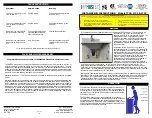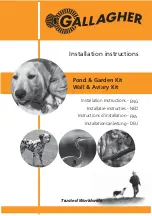
1-800-732-2677
14
Training
• Remember that this system is not a solid barrier. Using it successfully requires that you spend some time training your pet.
• Finish each training session on a positive note with lots of praise and play. Remove the collar after each training session.
• While your pet is still learning the boundary, contain him by another means, such as with a pen or a leash.
• Put a separate non-metallic collar on your pet’s neck and attach a leash.
• Be sure to place the collar on your dog’s neck with the PetSafe
®
logo facing up.
• If your pet appears to be stressed, slow down the training schedule, add additional days of training or increase the amount of play time.
Common stress signals include pulling on the leash toward the house, ears tucked or pulled back, tail down or tucked between legs, body
lowered, nervous/frantic movement or stiffening of the pet’s body, lip-licking or yawning.
Day 1
For the first day, start with the collar set to level 1, tone-only. With
your pet on a leash and with his favorite treats on hand, allow him to
explore the pet area (
7A
). Allow your pet to cross the boundary (
7B
)
and hear the tone from the collar, then ask him to come back into the
pet area (
7C
) and praise and reward him. Your goal is for your dog to
associate being inside the pet area with rewarding experiences. Dogs
are sensitive. Keep your mood upbeat as dogs can understand when
you are happy or upset. Do 2 or 3 training sessions for about 10-15
minutes each. Do not try to do too much too quickly. More frequent
short sessions are better than less frequent, longer sessions.
Days 2–4
On days 2 through 4, repeat this process, but with the collar set to
level 2—the mildest static correction level. Closely observe your pet’s
behavior while he is in the boundary zone (
7B
), and note whether
or not your dog responds to the correction. Indicators of a response
are looking around in curiosity, flicking of the ears or scratching at the
collar. If he does not respond, check the fit of the collar to make sure the
contact points are making contact with his skin. If the collar is fit correctly
and your dog does not respond, then move up to the next correction
level and repeat the process. Do 2 or 3 training sessions for about
10–15 minutes each. Your goal is for your dog to consistently choose
to stay in the pet area. If necessary, add in more days of training before
moving on to the next step.
Days 5–8
On days 5 through 8, retain the collar settings from the last training
session, but stage some distractions to test your dog’s reliability. The
goal is to have your pet stay within the boundary even with new
temptations. Start with simple temptations and work your way up. Some
examples are:
• Have a family member cross from inside the boundary and exit it.
• Place a toy outside the boundary.
• Have a friend or neighbor walk another pet outside the
boundary area.
Remember to keep your pet on a leash throughout this process while he
is still learning the boundary. Also, never coax your pet to leave the pet area.
Be sure the extra collar does not put pressure on the contact points.
7A
7B
7C
Содержание Stay & Play PIF00-13663
Страница 1: ......






































